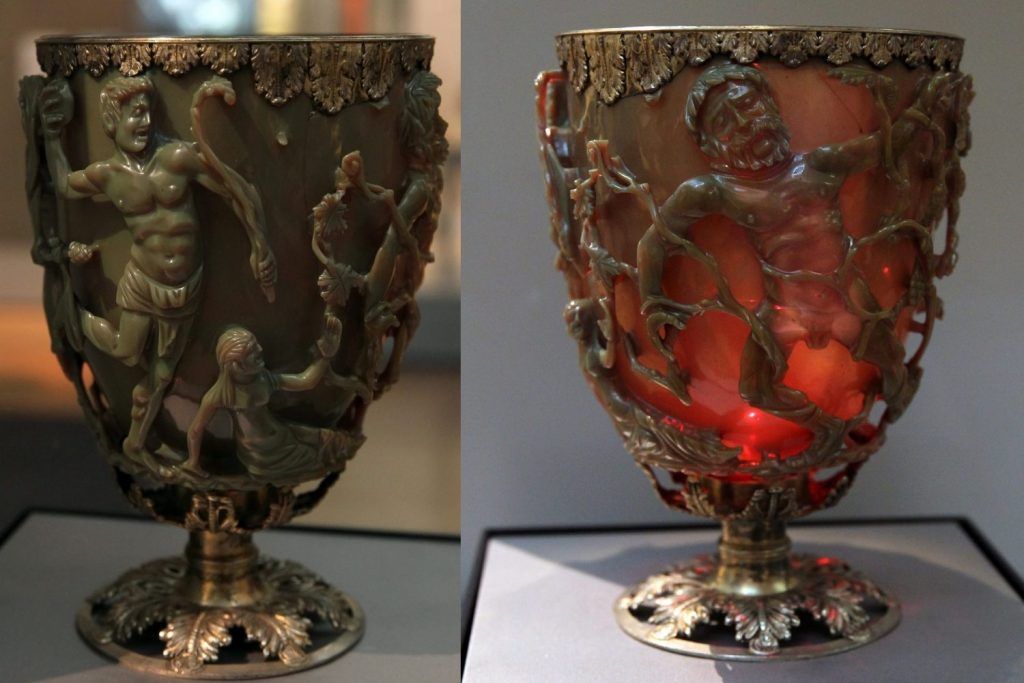One of the earliest known uses of nanomaterials was by the Romans to produce stained glass that changes color depending on the angle of the light source. A famous example is the Lycurgus cup, AD 300s[i], which is portrayed in The British Museum in London[ii]. The cup is a green opaque color when light is reflected and a red translucent color when it is transmitted. In addition, it decoratively depicts the legend of king Lycurgus who gets killed by vines. It is an example of dichroic glass and achieves this effect by a mixture of gold and silver nanoparticles.
Content
- What is Nanotechnology?
- How the Lycurgus Cup Works
- What Lies Ahead of Nanotechnology
- References
What is nanotechnology?
Nanotechnology is a multidisciplinary field revolving around science and engineering of materials and structures on the nanoscale which is defined as 1-100 nm. This scale is around 1,000-100,000 times smaller than the width of a human hair. The field has attracted the attention of physicists, chemists, material scientists, biologists, and more and resulted in many great modern-day electronics such as smartphones and QLED displays, but interestingly also in ancient uses.
How the Lycurgus cup works
The dichroic effect is due to nanoparticles of gold and silver alloys the size of 50-100 nm. Investigating the cup using X-rays shows the ratio of silver and gold to be around 7:3. The gold is responsible for producing the red color by absorbing some of the light, whereas the silver produces the green color by scattering or reflecting the light. Furthermore, the glass contains about 10 % copper.[iii]
We might not normally think of gold as red and silver as green. The reason for these colors is due to the dependence of shape and size when the particles are at the nanoscale. Another example of this effect is seen in medieval church windows of different colored stained glass where gold particles are used to produce red, green, or yellow and silver to produce yellow, blue, or red by changing the shapes and sizes. A somewhat similar effect is used in today’s Quantum Dot displays.
While we call this nanotechnology, the roman or the medieval glass workers most likely did not know why their process for creating the glass worked. They were most likely experimenting with different processes and accidentally found out how to make the dichroic glass used in the cup. However, it is still an impressive accomplishment for the time that should be acknowledged.
Nevertheless, the beginning of nanotechnology as a discipline is often attributed to Richard Feynman who was one of the first to understand the possibilities of engineering at this scale and who held the first lecture on atomic-scale engineering in 1959 called “There’s Plenty of Room at the Bottom”. The term Nanotechnology was coined in 1974 by the Japanese physicist Norio Taniguchi[iv].
What lies ahead of nanotechnology
What often sparks the most enthusiasm in the field of nanotechnology is in applications within the healthcare sector. Extensive and high-impact research is being done in drug-delivery, nanosensors, etc.. These applications show a lot of promise to save or improve people’s lives. However, applications such as these, with sometimes unknown implications, require a lot of testing to pass regulations and make it to consumer products.
Nanotechnology influences almost every industry. The electronics industry has been heavily benefited by nano-fabrication techniques which allow us to have smartphones. Composite materials have been improved with carbon nanotubes to make them stronger, and the cosmetics industry has created better sunscreens using titanium dioxide and zinc oxide nanoparticles[v], to name a few examples.
If you’d like to learn more about nanotechnology, please subscribe to our newsletter and stay tuned for upcoming posts.
Note: The images used are reprinted under Creative Commons CC0 1.0 Universal Public Domain Dedication and provided by the British Museum.
References:
[i] The British Museum, description
[ii] The British Museum, The Lycurgus Cup, accessed at https://www.britishmuseum.org/collection/object/H_1958-1202-1
[iii] History of Nanotechnology, https://www.ncbi.nlm.nih.gov/pmc/articles/PMC6982820/
[iv] Chemistry at the Nanoscale, DTU Chemistry, 2020, p. 3
[v]Nanotechnology in cosmetics: Opportunities and challenges, Silpa et. al, accessed at https://www.ncbi.nlm.nih.gov/pmc/articles/PMC3425166/,


Loved it! Super interesting and I didn’t know this cup exsisted very interesting to know it’s due to the nano scale of some of these materials like gold and silver and how they were used back then and how we use them now. Very enjoyable read. Got yourself a subscriber!!!
Thanks for your comment, André. I’m happy that you found it interesting, and it’s great to have you on board as a subscriber!